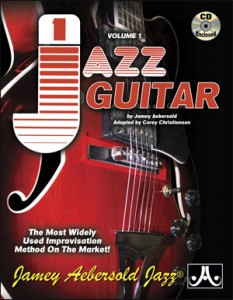Chromaticism
For those who are unaware, chromaticism means moving using half step intervals. Because the Chromatic Scale contains all twelve notes, there is only one Chromatic Scale. The shapes outlined on page 51 are moveable and still have a “tonic.” For instance, a “C” Chromatic Scale would contain the same pitches as a “G” Chromatic Scale, but the “C” chromatic would start and end on “C”, whereas the “G” Chromatic Scale would start and end on “G”. When writing a Chromatic Scale, “#’s” are used when ascending, and “b’s” are used when descending. Therefore, an “A#” Chromatic Scale is the same ascending as a “Bb” Chromatic Scale descending. Make sense? Alright! Now that we’ve established what a Chromatic Scale is, how do you use it?
Keep in mind that any note can be played against any chord symbol if it is properly led into and properly released…tension and release.
Taking this into account, the next six pages are devoted to various ways to employ the Chromatic Scale in your playing. I’m sure these pages are not the only ways to use the Chromatic Scale, but merely some of the simpler ones. For instance, approaching chord tones from a half step below. Personally, I like this one quite a bit. Or, if you’re trying to play a fast arpeggio and you miss your notes by a half-step, just say you were improvising with the Chromatic Scale! Another way you can employ it is by using the scale tone above each chord tone, and using the half step leading tone from below. These are just the first of many ideas presented in the text. Chromatic lines can add a mature sound to your playing, but, like anything else in jazz, take time to learn and memorize. Major jazz players will be able to fuse scales and chord tones, but I know they didn’t learn that overnight.
On a side note, as I have mentioned, I am but a wee fledgling jazz player, and do not perform often with other jazz players (an advantage of having the play-a-longs). However, I do play every weekend at my Church. When the band is playing a worship song, and the congregation is singing along, and someone improvises with a little chromaticism, it may or may not be appreciated. Not that this happened to me, of course… But I have this friend, who, well… Anyway! I feel it’s important to know why you’re playing, and who you’re playing for. Which leads us to…
Playing The Blues
Blues, like jazz, started as an aural, rural musical tradition. Learned from other players and by “jamming” with each other, these styles encourage emotional and improvisational playing. The styles and forms of blues music are often used as a gateway style for many players wanting to learn jazz. I was playing the blues long before I ever thought about venturing into jazz music. It’s a very natural transition. However, jazz blues is a fast evolving music in a vast arena of tonal possibilities.
One tip that Jamey gives on page 58, is to sing improvised phrases. In many ways, this is closer to the “Real You” than improvising on your instrument will achieve. Also, Jamey says it is hard to sing wrong notes. I’m not saying it’s true, I’m just saying that’s what Jamey says… There are reasons I’m a guitar player.
Anyway, try to record your voice, then go back with your instrument to copy these phrases.
Knowing your instrument inside and out will also help you convey your musical ideas. This volume is geared specifically for guitar, but all the musical principles still apply to any instrument. Many times, when people find out I’m a musician, the first thing they ask is, “What do you play?” Almost always, my answer is something like, “I can play many instruments, but I play guitar well.” Some people laugh, some look confused, and a few get annoyed. I see it like this; if you have to constantly think about how to play your instrument, how can you be expected to improvise or embellish chords and phrases? Ask me to improvise on guitar, I’ll be fine. Ask me to improvise a keyboard solo, you’ll be lucky to get some triad arpeggios.
Now, the blues can have many different chord progressions, varying from simple to complex harmony in the chords. The more notes you add to the chords (Harmonic structure), the jazzier it sounds. In jazz, it’s expected that the music will change. Here are Jamey’s steps to practicing the blues, without using the Blues Scale.
- 1. Get the feel of the roots first
- 2. Then the first five notes of each scale
- 3. Then the triad (root, 3rd, and 5th)
- 4. And finally the entire scale
Jamey advises using this method of practice when approaching any new song or chord progression. After imparting a few more bits of wisdom to us, we are provided with some original blues melodies by Jamey himself to play starting on page 66. These melodies can be played respectively over the Bb, or F blues tracks provided.
Be methodical in the way you approach your practice sessions
Hmmm… maybe some chromatic blues? It’s a thought! Please keep checking up with me as play through Volume 1 for Guitar!

